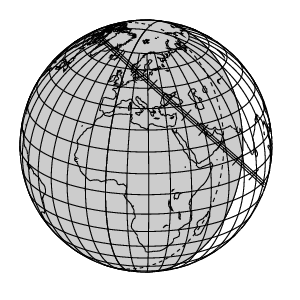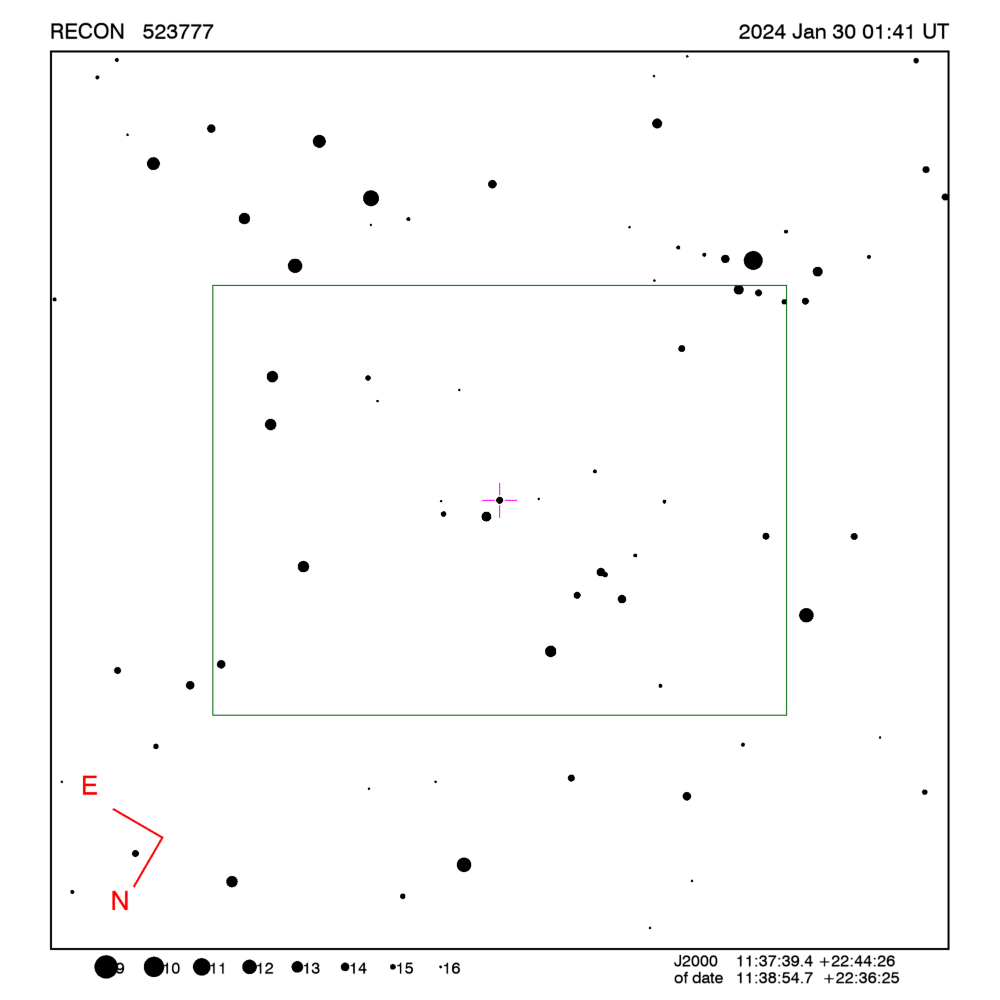RECON: TNO occultation with 523777
Event between (523777) 14YF50 and star GA1120:03307992
with event index number of 2611949
Geocentric closest approach at 2024/01/30 01:47:24 UTC
J2000 position of star is 11:37:39.4 +22:44:26
Equinox of date position of star is 11:38:54.6 +22:36:26
Stellar brightness G=15.0,
use SENSEUP=128 with the MallinCam and and exposure
time of 2 seconds with the QHY174 camera.
Star is 20 degrees from the moon.
Moon is 84% illuminated.
Apparent brightness V=21.0
 Object is 35.8 AU from the Sun
and 35.0 AU from the Earth.
Object is 35.8 AU from the Sun
and 35.0 AU from the Earth.
Apparent velocity is 18.9
km/sec on the sky relative to the star, or,
2.7 arcsec/hr.
The 1-sigma error in the time of the event is 81 seconds.
The 1-sigma cross-track error in the shadow position is
1536 km.
The object has an absolute magnitude Hv=5.4
Diameter=501.2 km assuming a 5% albedo -- 26.6 sec chord
Diameter=204.6 km assuming a 30% albedo -- 10.9 sec chord
Dynamical classification is SCATNEAR
Star training set for 523777, (2024/01/30 01:41UT)
Object RA Dec mag sep mel
Regulus 10:09:39.2 +11:50:55 1.3 23.83 27
68Del Leo 11:15:23.1 +20:23:29 2.6 5.90 20
92 Leo 11:42:02.0 +21:13:08 5.3 1.57 19
PPM 101321 11:41:24.5 +23:34:29 6.9 1.13 21
PPM 101314 11:41:02.9 +22:57:03 9.8 0.60 20
PPM 101297 11:39:36.3 +22:48:06 10.5 0.25 20
523777 11:38:54.7 +22:36:25 15.0 20
Positions are for equinox of date

Azimuth is measured in degrees eastward from north.
North is at an azimuth of 0, due East is at an azimuth
of 90 degrees, due South is 180, and due West is 270.
Do not use the listing below for the RECON CPC 1100 telescopes.
This is provided for other non-team facilities.
Star training set for 523777, (2024/01/30 01:41UT)
Object RA Dec mag sep mel
Regulus 10:08:21.9 +11:58:02 1.3 23.83 27
68Del Leo 11:14:06.7 +20:31:22 2.6 5.90 20
92 Leo 11:40:47.0 +21:21:09 5.3 1.57 19
PPM 101321 11:40:09.2 +23:42:30 6.9 1.13 21
PPM 101314 11:39:47.6 +23:05:04 9.8 0.60 20
PPM 101297 11:38:21.0 +22:56:07 10.5 0.25 20
523777 11:37:39.4 +22:44:26 15.0 20
Positions are for J2000
Event circumstances last updated at 2024/01/08 05:06:50 UT
Marc W. Buie,
Southwest Research Institute
RECON
 Object is 35.8 AU from the Sun
and 35.0 AU from the Earth.
Object is 35.8 AU from the Sun
and 35.0 AU from the Earth.
